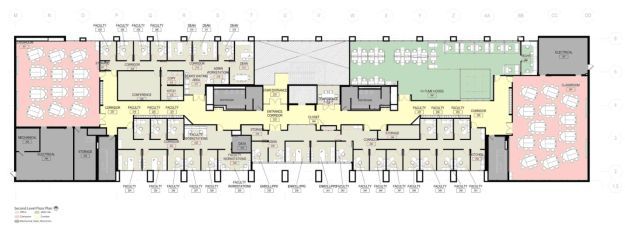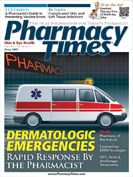Publication
Article
Pharmacy Times
Innovations in Education
Author(s):
Roosevelt University College of Pharmacy offers a unique 3-year program with state-of-the-art facilities.
FRONTIERS IN PHARMACY
New Interactive Approach Simulates Real-Life Situations in an Executive MBA-Like PharmD Program
When Roosevelt University began developing its College of Pharmacy, it made a series of choices right from the start to help distinguish it from other programs. The first was hiring a leader familiar not only with pharmacy practice but also health sciences education. In 2009, the university selected George E. MacKinnon III, PharmD, RPh, FASHP, as the founding dean. Recognized as an innovator in pharmacy education and practice, Dr. MacKinnon previously helped establish colleges of pharmacy in Arizona and Illinois.
“As a pharmacist, I believe that the pharmacy degree is the ‘engineering degree of the health sciences,’” Dr. MacKinnon said. “It is the competent pharmacist in community pharmacies, hospitals, and long-term care facilities who helps patients and other health care providers improve health outcomes with medications, monitoring, and counseling.”
The college, which received its precandidate accreditation from the Accreditation Council for Pharmacy Education in January 2011 and the Higher Learning Commission accreditation in June 2011 for the doctor of pharmacy (PharmD) program, stands out most notably for using a 3-year accelerated concept, the first of its kind in the Midwest. Other hallmarks of the new program are small class sizes, an integrated curriculum, use of labs and experiential rotations in every term, and a dedicated focus on group and cooperative learning.
Assisting Dr. MacKinnon in the implementation of the 3-year program was David Fuentes, PharmD, associate professor of clinical sciences at Roosevelt. Dr. Fuentes previously taught at Pacific University in Hillsboro, Oregon, which also uses the 3-year pharmacy model.
“With this 3-year model, our students will not only get that extra year off, but they will be completely immersed while they’re here. From the middle of the semester on, they’re in the zone,” he said. The inaugural class of 66 students began coursework on July 5, 2011.

Custom-Built Facilities
Roosevelt’s pharmacy facilities were custom built on the second floor of the school’s 230,000-square-foot building in Schaumburg, Illinois, a suburb about 30 miles northwest of downtown Chicago. The 16,000-square-foot space dedicated solely to pharmacy education was constructed with a suite concept in mind. The lab, classroom, and administrative spaces are intermingled, facilitating interactions among students, faculty, and administration. The Schaumburg Campus also features student commons and lounges, study areas, and a library that support the university’s 4 other colleges.
Small class sizes were a priority, so the pharmacy facilities were designed to accommodate a maximum of 78 students per incoming class (in multiples of 6). The 2 Interactive Learning Centers are the closest thing to a traditional classroom at the college. Students sit in semicircular tables, or “pods,” comprised of 6 individuals as opposed to linear stadium seating in large lecture halls, where often students are packed shoulder to shoulder.
The classrooms were designed as interactive learning centers to stimulate student collaboration and active learning strategies. The rooms are technologically advanced with group tables wired for computer access, smart boards, and a 4-foot band of paint that functions as a dry erase board. To eliminate the problem of software compatibility and streamline digital instruction efforts, each student is issued an Apple MacBook, ensuring the easy transfer of digital materials.
An important component of the facility is the Critical Skills Assessment & Simulation Laboratory, a large, customizable simulation environment where students learn a variety of occupational skills, later to be reinforced by their experiences working with profession- als in real-life situations. The room was designed to be fully customizable, utilizing a modular (drywall-free) configuration that can be reorganized or adapted as professional environments change.
Cara Brock, PharmD 2003, formerly a retail pharmacist for 7 years, teaches students the practical skills needed for working with patients in clinical environments in Roosevelt’s Pharmaceutical Care Lab. “In the classroom, students learn all their didactic materials. In the lab is where they learn how to apply that,” she explains. “They learn how to interact with doctors and patients, how to counsel patients on their medications, how to use testing devices, and so on.”
Her philosophy is to lead students to the answers, but to let them find the results themselves. A unique aspect that Drs. Brock and Fuentes added to the lab is the concept of a “Clinical Skills Passport,” whereby students will develop competencies in patient assessments, including blood pressure measurements, immunization administration, and use of point-of-care devices.
“In the College of Pharmacy, our labs do not just focus on selecting drugs and dispensing them,” said Dr. Fuentes. “They mimic what patients encounter in clinical settings. Students practice the patient interview skills they need. It’s very rare to have space dedicated for that use.”
Presently, the facility houses 2 dedicated research labs in the areas of pharmaceutics and drug delivery, medicinal chemistry and biochemistry, pharmacology, and translational clinical research. There are plans to expand to 4 labs.
Group Environments
A key tenet of Roosevelt’s College of Pharmacy is its heavy emphasis on group learning, which is evident in the design of classrooms and lab environments. From the start of the program, students are grouped into sets of 6, and they will remain in the same group throughout the 3-year program. In many cases, students must work together to complete assessments as a team, as well as individually.
Dr. Fuentes reports that this effectively simulates common workplace settings, and will better prepare students for the challenges of working with others when they enter the field. “Because of the way the classrooms are oriented, students have no choice but to use their team building skills and a team approach,” he said. “If you want to sneak in late and not participate in class, then this program is not for you.”
Mentor Program and Practicum
In the Pharmacist Mentor program, 66 pharmacists team with the 66 first-year PharmD students to provide professional and personal support for students during 3 years of pharmacy education.
During the first and second professional years, students are required to complete 320 hours of IPPEs, or Introductory Pharmacy Practice Experiences, over 40 weeks. The college introduces the concept of Inter-professional Practice Experiences (IPEs) in the second professional year, where students will spend 160 hours with other health care providers. Students are provided exposure to 4 core areas: 1) home health and hospice; 2) convenient care clinics; 3) medically underserved; and 4) other providers from the fields of medicine, nursing, psychology, physical therapy, occupational therapy, social work, and case management.
Combined with pharmacy-specific experiences, this gives students a more rounded and fully-formed idea of what their role as pharmacists will require. The final year culminates with students completing 6 full-time (40 hours/week) experiences in Advanced Pharmacy Practice Experiences (APPEs) totaling more than 1440 hours over 36 weeks. Total internship hours upon graduation will be about 2000 hours.
Social Justice Mission
Roosevelt University’s unique identity as a school founded on principles of social justice has shaped the pharmacy program. The faculty is dedicated to educating pharmacists who will be competent, committed, and compassionate— preparing them to successfully meet the challenges of the ever-changing health care marketplace. These “3 C’s” are the school’s guiding principles, and they help shape the nature of the instruction.
The initial class has formed its own advisory committee to relay information from students to faculty about shaping the program in the future. Many students in the program hail from small towns in the Midwest and beyond, and Drs. Fuentes and Brock are hopeful that they will return to their hometowns to practice or work in areas with underserved populations where pharmacists are in great need. The college is also working to establish a network of rural sites so students can be exposed to these opportunities.
“Some people have said that we have created an ‘Executive MBA-like PharmD program,’” Dr. MacKinnon said. “I believe we are taking an innovative, yet practical, approach to pharmacy education.”









